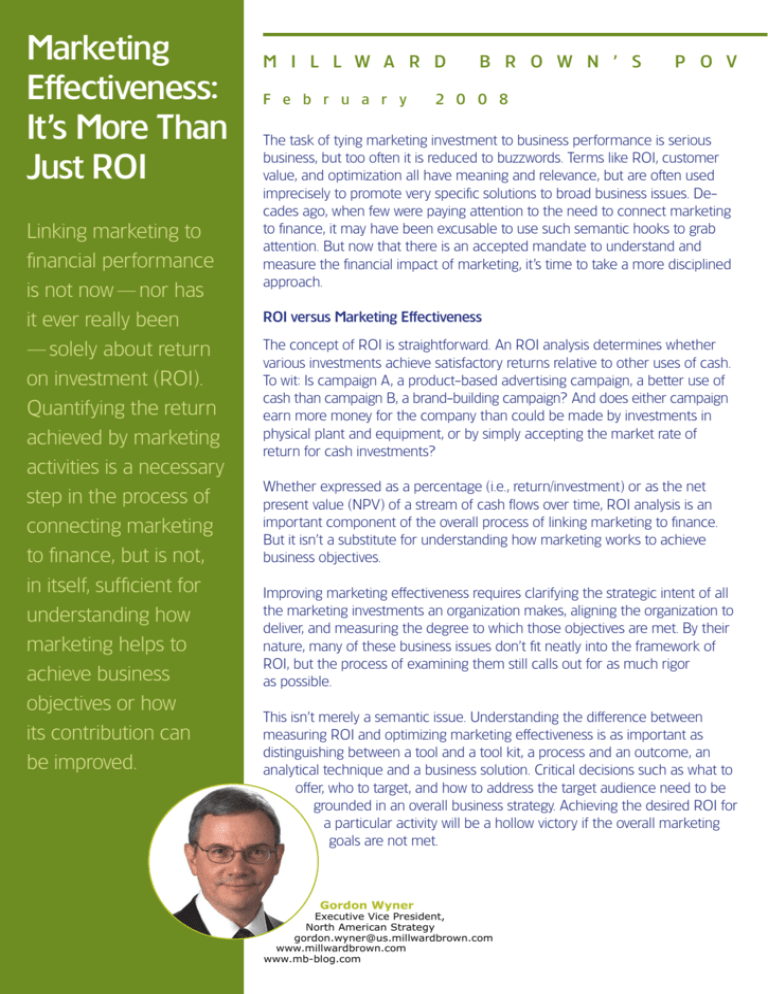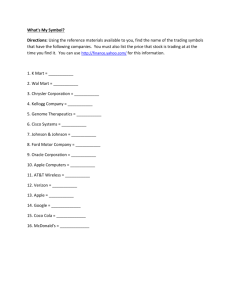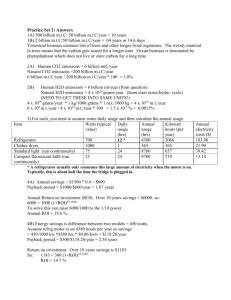Marketing Effectiveness: It's More Than Just ROI
advertisement

Marketing Effectiveness: It’s More Than Just ROI Linking marketing to financial performance is not now — nor has it ever really been — solely about return on investment (ROI). Quantifying the return achieved by marketing activities is a necessary step in the process of connecting marketing to finance, but is not, in itself, sufficient for understanding how marketing helps to achieve business objectives or how its contribution can be improved. M I L L W A R D F e b r u a r y B R O W N ’ S P O V 2 0 0 8 The task of tying marketing investment to business performance is serious business, but too often it is reduced to buzzwords. Terms like ROI, customer value, and optimization all have meaning and relevance, but are often used imprecisely to promote very specific solutions to broad business issues. Decades ago, when few were paying attention to the need to connect marketing to finance, it may have been excusable to use such semantic hooks to grab attention. But now that there is an accepted mandate to understand and measure the financial impact of marketing, it’s time to take a more disciplined approach. ROI versus Marketing Effectiveness The concept of ROI is straightforward. An ROI analysis determines whether various investments achieve satisfactory returns relative to other uses of cash. To wit: Is campaign A, a product-based advertising campaign, a better use of cash than campaign B, a brand-building campaign? And does either campaign earn more money for the company than could be made by investments in physical plant and equipment, or by simply accepting the market rate of return for cash investments? Whether expressed as a percentage (i.e., return/investment) or as the net present value (NPV) of a stream of cash flows over time, ROI analysis is an important component of the overall process of linking marketing to finance. But it isn’t a substitute for understanding how marketing works to achieve business objectives. Improving marketing effectiveness requires clarifying the strategic intent of all the marketing investments an organization makes, aligning the organization to deliver, and measuring the degree to which those objectives are met. By their nature, many of these business issues don’t fit neatly into the framework of ROI, but the process of examining them still calls out for as much rigor as possible. This isn’t merely a semantic issue. Understanding the difference between measuring ROI and optimizing marketing effectiveness is as important as distinguishing between a tool and a tool kit, a process and an outcome, an analytical technique and a business solution. Critical decisions such as what to offer, who to target, and how to address the target audience need to be grounded in an overall business strategy. Achieving the desired ROI for a particular activity will be a hollow victory if the overall marketing goals are not met. Gordon Wyner Executive Vice President, North American Strategy gordon.wyner@us.millwardbrown.com www.millwardbrown.com www.mb-blog.com The Limits of ROI The limitations of ROI are easy enough to understand when one considers that by definition an ROI analysis calls for a well-defined “I” (the investment) and a well-defined “R” (the return). But even when “R” and “I” can’t be pinned down precisely, there are still crucial decisions to be made, decisions that carry major financial implications. For example, key strategic directions must be chosen even without precise information on the available investment. Many phases of strategic decision making are fraught with uncertainties, unknowns, and approximations. Take segmentation. Most organizations use segmentation to identify the most attractive customers, upon whom they will focus disproportionate resources. The 80/20 rule for customer value often governs; i.e., a small portion of customers account for a huge portion of overall financial value. Thus the segmentation decision is extremely important, at least somewhat quantifiable, and ought to be financially driven. But measures of current use, purchase, revenue, and profit, useful though they may be, cannot always precisely predict the lifetime value of a customer. An example from the airline industry highlights this issue. In one study, multiple measures of customer financial value (based on recent travel behavior) highlighted the segments to be pursued. Yet it was virtually impossible to predict the customer’s behavior a year or two in the future for quantifying NPV, because of the changes that occurred in traveling patterns over time. For example, in a particular year, a heavy business traveler might make multiple trips between New York and London to meet with an important customer. Of the available airlines, A and B, the traveler prefers A. The next year, the same businessperson might be servicing an account in Los Angeles rather than London. Airlines available for that route may be C and D. Airline A may think they have a lost customer in need of “saving,” but in reality the needs of the customer have simply changed. Under circumstances like these, the concept of NPV becomes extremely “fuzzy” and unpredictable unless you can anticipate all the drivers of behavior. But even if NPV cannot be predicted, an effective and financially oriented market segmentation can be assembled by combining behavioral data with shareof-wallet surveys and market-responsiveness tracking. This approach, though far from true ROI evaluation, can point up enormous financial implications. The design of products also calls for major financial decisions in the early stages of development. These can defy ROI calculations for several reasons. One is that until the new product platform is finalized, the cost of manufacturing can only be approximated. Another is that these manufacturing costs will vary depending on the product’s specific features, which aren’t fully known until later on in the process. Research can help to identify the configurations likely to maximize customer choice relative to competition, but it cannot produce accurate multiyear sales forecasts, nor can it predict changes in a competitive market. However, after the basic product parameters are finalized, more focused sales and profit forecasts and more refined ROI estimates can be made. Large budgets might be spent against the wrong customer target, the wrong objective, or the wrong touch point. An ROI analysis would report a financial failure but would not shed light on why it happened. Between “R” and “I” Even when “R” and “I” can be precisely stated, focusing too intently on dollars in versus dollars out may not do justice to everything that happens in between. Consider fundamental marketing tasks like creating brand awareness and presence in the market, achieving a place in the customer’s consideration set, and positioning the brand with specific benefits relative to the competition. All of these require significant investment before the dollars of return can start pouring in. Several marketing processes have to unfold, on various timeframes, in order for these intermediate outcomes to lead to customer choice, revenue, and profit. Some would argue that, because it has no direct financial outcome, an intermediate step such as awareness generation is worthless for assessing business performance. But we believe it’s critical to understand these intervening processes. Large budgets might be spent against the wrong customer target, the wrong objective, or the wrong touch point. An ROI analysis that focuses only on the end result would report a financial failure, but would not shed light on why it happened. Without an understanding of the flow of the process, it may be difficult to discern why success or failure occurred and, in the case of failure, what action to take. For example, the Softer Side of Sears campaign succeeded in stimulating store visits, but did not generate more purchases. Further diagnosis of conversion from shopping to purchase revealed that customers were disappointed in the selection of merchandise available. Expectations had been successfully raised, but weren’t satisfied. Measurement of the intermediate processes will shed light on what is working and what isn’t in creating revenue and profit, and what marketing levers should be exercised to achieve the desired outcomes. Creating a diagram to show the influence of the various levers on customer behavior is often useful in identifying where the yield from marketing investment is good and where it falls down, and can provide a basis for needed improvements and strategic redirection. In financial services we often depict a chain of intermediate objectives, such as those shown in Figure 1. We see that each objective, such as driving traffic to a site or facilitating the opening of accounts, is influenced by some but not all of the marketing levers. In this way, we can tie business and marketing objectives to relevant performance milestones and ensure that appropriate standards are applied in measuring performance. Just as operations managers shouldn’t be penalized for revenue shortfalls, marketing process owners shouldn’t be held to standards they can’t influence. If the marketing campaign is supposed to generate qualified leads and the sales force is supposed to close them, then the campaign is only indirectly responsible for sales revenue. The sales force is directly responsible for revenue, but only if it has qualified leads with which to work. Figure 1: Impact of Marketing Levers Marketing Lever Advertising Promotion Pricing Sales Personnel Service Personnel Drive Traffic Select Customers ¸ ¸ ¸ ¸ ¸ ¸ Service Account Cross Sell ¸ ¸ ¸ ¸ ¸ Revenue & Profit Financial results are not realized in spreadsheets and presentations, but in the field where actual interactions with customers happen. Effectiveness Depends on Execution Finally, it’s important to note that financial results are not realized in spreadsheets and presentations, but in the field where actual interactions with customers happen. Some of the most important steps in marketing effectiveness relate to execution against the chosen strategies and tactics. For a segmentation to be actionable, the people who have opportunities to interact with customers need to know the segments and have clear ideas of how to treat them based on that knowledge. One way companies achieve this is by creating rich visual descriptions and profiles of customer types and delivering them to all customer-facing employees. For example, marketing managers often display posters depicting representative customers in their work areas to reinforce the idea that employees should be thinking about how to address those types of customers in everything they do. If product introductions are to succeed, the product must achieve the quality levels specified in its test market phase, receive the promotional support specified in the forecasting models, and secure the field marketing and channel support needed to get the product in front of consumers. For marketing-mix planning to be useful, the tactical decision makers need to know how to apply the learning from the models; i.e., how to tailor plans based on what’s working and what’s not working. For example, by using simulation tools to run alternative marketing plan scenarios, they can find the ideal weight, schedule, and copy mix, along with selected pricing and distribution levels, to most efficiently and effectively achieve performance goals for sales and profit. Marketing Effectiveness: An Ongoing Process Our work with a major provider of consumer health products illustrates the importance of all these elements working together as part of an ongoing process. A segmentation analysis based on consumer needs, shopping behavior, financial value, and brand equity identified the major opportunity segments of the market. Subsequent conjoint trade-off analysis isolated several distinct elements of the product that, if modified, would likely increase profitable revenue. After these product changes were implemented and announced with appropriate messaging, performance was tracked on a continuous basis to ensure that messages were being received, understood, and acted upon. Having a comprehensive marketing effectiveness program enabled the client to manage their brand portfolio in a systematic, data-driven way while maintaining accountability to top management for monies spent. The goal of optimizing marketing effectiveness can’t be achieved through one single approach. Success depends on the integration of multiple methodologies and disciplines, all based on a common understanding of the marketing process. The importance of the financial opportunities and problems at different stages can be quite variable. For some companies, the best way to improve marketing effectiveness is through segmentation and product development improvements, while for others, mix-modeling will help them optimize the allocation of marketing spend. The key is to correctly define the problems before attempting to solve them. Don’t settle for a superficially simple answer to “What’s the ROI?” before understanding the workings of the overall marketing process. To read more about Marketing Effectiveness, please visit www.mb-blog.com.







